
The marketing term netbook identified small and inexpensive laptops that were sold from 2007 to around 2013; these were generally low-performance. While the name has fallen out of use, machines matching their description remain an important part of the market for laptops running Microsoft Windows. Similarly, most lower-end Chromebooks run on hardware which would have been described as "Netbooks" when the term was current, and inexpensive tablets when used with an external keyboard are functionally equivalent to netbooks.
The Intel Graphics Media Accelerator (GMA) is a series of integrated graphics processors introduced in 2004 by Intel, replacing the earlier Intel Extreme Graphics series and being succeeded by the Intel HD and Iris Graphics series.

An ultra-mobile PC is a miniature version of a pen computer, a class of laptop whose specifications were launched by Microsoft and Intel in spring 2006. Sony had already made a first attempt in this direction in 2004 with its Vaio U series, which was only sold in Asia. UMPCs are generally smaller than subnotebooks, have a TFT display measuring (diagonally) about 12.7 to 17.8 centimetres, are operated like tablet PCs using a touchscreen or a stylus, and can also have a physical keyboard. There is no clear boundary between subnotebooks and ultra-mobile PCs, but UMPCs commonly have form factors other than the common clamshell laptop design, such as having small keys on either side of the screen, or having a slide-out keyboard.
The Classmate PC, formerly known as Eduwise, is Intel's entry into the market for low-cost personal computers for children in the developing world. It is in some respects similar to the One Laptop Per Child (OLPC) trade association's Children's Machine (XO), which has a similar target market. Although made for profit, the Classmate PC is considered an Information and Communication Technologies for Development project (ICT4D). Introduced in 2006, the device falls into the then popular category of netbooks.

Asus Eee is a family of products by AsusTek Computer Inc. The product family began with the release of the Eee PC subnotebook in 2007; since then, the product family has diversified into a number of PC form factors. According to the company, the name Eee derives from "the three Es," an abbreviation of its advertising slogan for the device: "Easy to learn, Easy to work, Easy to play".
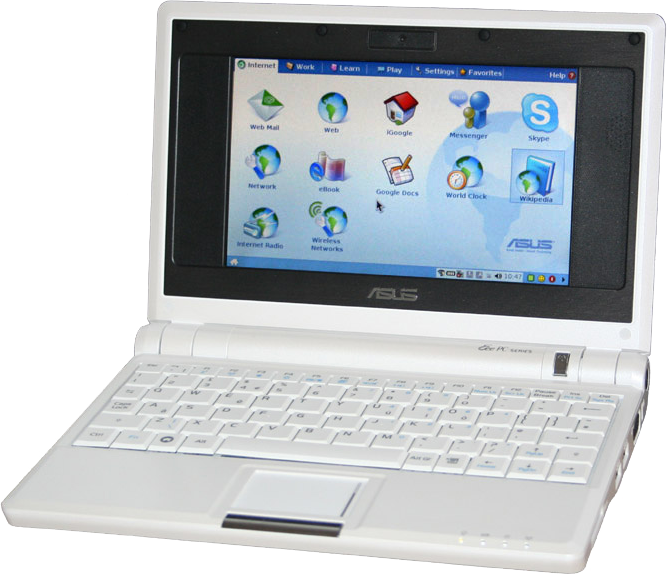
The ASUS Eee PC is a netbook computer line from Asus, and a part of the ASUS Eee product family. At the time of its introduction in late 2007, it was noted for its combination of a lightweight, Linux-based operating system, solid-state drive (SSD), and relatively low cost. Newer models added the options of Microsoft Windows operating system and rotating media hard disk drives (HDD), and initially retailed for up to 500 euros.
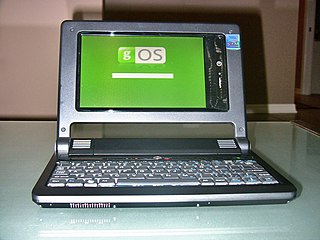
The CloudBook is a discontinued x86 subnotebook, or Ultra-Mobile PC developed by Everex using a VIA processor, chipset, and NanoBook reference design. It competed with the Asus Eee PC, the OLPC XO-1 and the Classmate PC. The device was categorized as a netbook when it was around 2008.
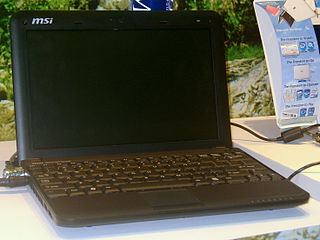
The MSI Wind Netbook was a family of subnotebooks / netbooks designed by Micro-Star International (MSI). Wind stands for "Wi-Fi Network Device". The first model was announced at CeBIT 2008, and first listed for pre-orders on May 9, 2008. While initially 8.9- and 10.1-inch screen versions existed, as of 2010 only the 10.1" remained, with a resolution of 1024×600. While most models had 1 GB of RAM, some had 2 GB, and hard disks ranged from 80 GB on the oldest to 250 GB on the newest models. Also featured were Bluetooth, WLAN and a 1.3 megapixel camera. The Wind PC was MSI's response to the successful Asus Eee PC. The keyboard was 92% of full-size.

The HP 2133 Mini-Note PC was a full-function netbook aimed at the business and education markets. It was available with SUSE Linux Enterprise Desktop, Windows Vista or Windows XP. Its retail price started at US$499 for the Linux version with 4GB of flash memory. According to DigiTimes, the netbook was manufactured by Inventec. However, according to APC magazine, it was built by Compal Electronics who also make the MSI Wind and the Dell Inspiron Mini 9. The system was replaced in early 2009 by an upgraded model, the HP Mini 2140, which was also aimed at the education and business market.
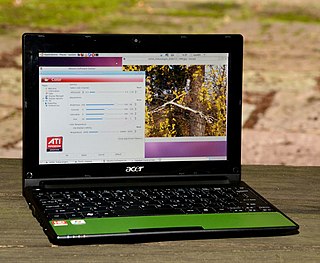
Acer Aspire One is a line of netbooks first released in July 2008 by Acer Inc.
These tables provide a comparison of netbooks.

The first netbook offering by Gigabyte, the M912, is a hybrid netvertible Tablet PC device, was released in 2008. It features an Intel Atom processor and comes preloaded with either Windows XP, Windows Vista or a customised Linux distribution. The hardware varies slightly depending on the OS chosen. The Linux Version for example does not include Bluetooth and has a lower resolution screen. Press accounts suggest that there may be significant heat and speed issues compared with other netbooks. Other criticisms focus on Gigabyte's choice to ship one variant with Windows Vista Home Basic, which lacks official Tablet PC support.

A nettop is a small-sized, inexpensive, low-power, legacy-free desktop computer designed for basic tasks such as web browsing, accessing web-based applications, document processing, and audio/video playback. The word nettop is a portmanteau of network and desktop. It is the desktop counterpart of the netbook. Modern mini PCs or small form factor PCs can be much more powerful, being equipped with high-end laptop components or mid-range desktop components.

The Samsung NC10 is a subnotebook/netbook computer designed by Samsung. At the time of its introduction (2008), it was noted for its combination of a 10.2" screen and large 6-cell battery as standard, giving a battery life of up to 7.5 hours, a large hard disk drive and a release price of 499 USD.
Nvidia Ion was a product line of Nvidia Corporation intended for motherboards of low-cost portable computers. It used graphics processing units and chipsets intended for small products.

The Sony Vaio P series is a range of ultraportable subnotebook computers launched in January 2009.
The Dell Inspiron Mini Series is a line of subnotebook/netbook computers designed by Dell. The series was introduced in September 2008 amidst the growing popularity of low-cost netbook computers introduced by competitors.

HP Mini is a former line of small computers categorized as netbooks manufactured by Hewlett-Packard. They either contained a custom version of Ubuntu Linux, Microsoft Windows XP Home Edition or Windows 7 Starter operating system. Like most netbooks, they were not built with CD/DVD drives. However, HP did sell portable DVD-ROMs with HP's LightScribe disc imaging software. These netbooks are best used for written documents, small programs and web browsing. They can run standard software, but given their low price, they tend to have low end specifications, causing poor performance. They were announced from mid-2007, and marketed from 2008 through 2012.
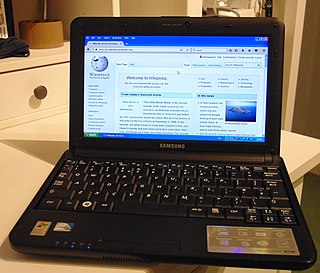
The Samsung N130 is a subnotebook/netbook computer designed by Samsung. At the time of its introduction, it was noted for a good keyboard, large 6-cell battery as standard, giving a battery life of up to 7.5 hours a medium 160gb SATA hard disk drive and a release price of 349 USD.

The IdeaPad S Series is a series of notebook computers launched by Lenovo in October 2008. The IdeaPad S10 was initially scheduled for launch in September, but its release was delayed in the United States until October.














